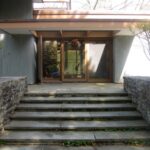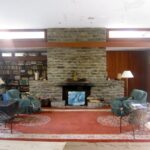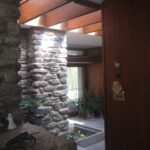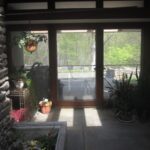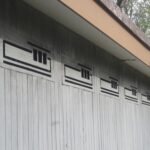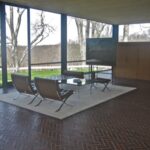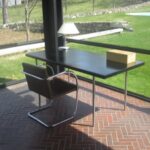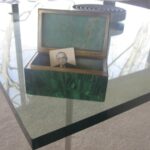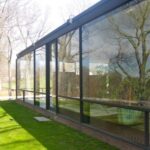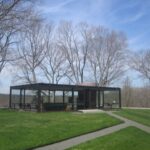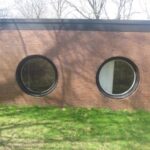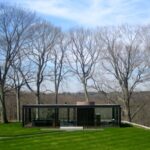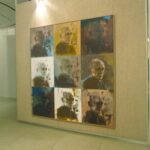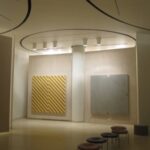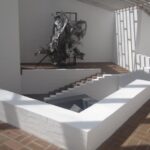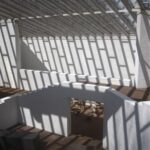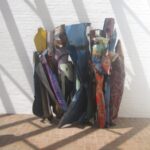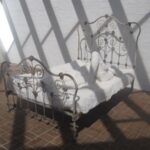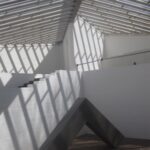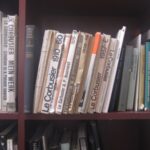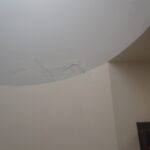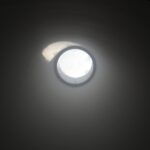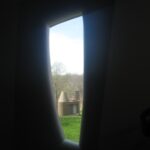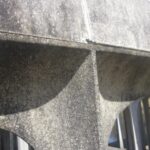Of the many individuals who found themselves in the orbit of Philip Johnson over his long life, Landis Gores stands as one of the more fascinating. He was a native of Ohio (like Johnson) who loved horses (he met his wife on a ranch in Wyoming) and played football at Princeton. He met Johnson at Harvard, where the two studied architecture (Gores, though younger, was a class ahead) and developed a shared a friendship based on their interest in the classics and a taste for the kind of modern architecture that was not fashionable under Walter Gropius. Johnson preferred Mies; Gores was more of a Wright man, as the house he built for himself in New Canaan, just after the war, makes plain. Gores’s wartime service had been exemplary; he was a part of the now justly mythologized code-breaking team, based in Bletchley Park, England, that broke the cyphers of the Nazi high command. Upon return from the war, he was recruited by Johnson, who needed a deputy to assist him in practice. The collaboration was not too long; Gores, talented in his own right, was anxious to go off on his own. His house, however, though quite different from Johnson’s nearby Glass House, was also in many ways modeled on it; set on a promontory with a view; broad expanses of glass opening out onto nature. Gores, sadly, was stricken with polio just a few years after opening his own office, and before the release of the Salk vaccine. It was the end of a promising career. A few more images of the house, designed when Gores was all of 26 (!), follow.
Month: April 2010
Staggered Profiles
Back when I was in high school, some 25 years ago (ouch), the Whitney was already mired in controversy over its expansion plans. Michael Graves was the culprit then. Rem Koolhaas would come along in later years, and Renzo Piano after him. Marcel Breuer’s gray granite fort somehow resisted all comers, a fact for which we should all be very glad. The Whitney has never given up its dreams, however, and now has its eyes on a plot at the foot of the High Line in the Meat Market, with Piano as designer. I hate to think of the Whitney decamping from the Upper East Side, though I can appreciate the museum’s desire for more gallery space. A satelite downtown sounds appealing, but like many of the trustees, I fear the costs of operating it might be prohibitive. The Guggenheim’s downtown outpost didn’t work out. When big plans go awry, it’s always the little guys at a museum—the registrars and librarians and designers and guards—who get stuck with the brunt of the pain.
The news about the Whitney’s expansion drew a rather splenetic response from Times art critic Roberta Smith, no fan of Breuer’s building. It has, she wrote, “all the disadvantages of starchitecture and few if any of the rewards. Even in a country where museums are rarely designed with art in mind, it stands out as relentlessly unforgiving to works of all styles and periods. If the stone floor doesn’t kill, the oppressive overhead concrete structure almost undoubtedly will. Unlike the Guggenheim, the Breuer building is not considered a must-see destination by tourists, regardless of what shows are on view.”
I’d just like to add my voice to those who find that opinion—and the nasty tone in which it is voiced—objectionable. Yes, the building has a brooding profile, but I’ve never found it resistant to art. The Whitney has a personality, and it actually belies first impression. You cross over that moat, and it’s like you’re in a place out of time. It’s not oppressive. It’s the one New York museum that has a sense of humor, that doesn’t have airs. MoMA is Imperial. The Goog is chic. The Frick and the Morgan are old money. The MET is an encyclopedia. The Whitney? It’s Calder’s circus, Stuart Davis, Oldenburg’s soft toilet, all those biennials that everyone hates—it’s the 1962 Mets of New York art museums. (Those ’62 Mets, incidentally: owned by a Whitney.) It even has its own scent. The Whitney smells like no other place in the world.
Perhaps I’m jaded by my own history, but I happen to think Breuer’s stone flagging and concrete ceilings do just fine for art, thank you very much. Idiosyncratic? Sure, but that’s okay. I hate to think that the only way to look at modern art is in giant white-walled warehouses. As for popularity, the place seems to be doing pretty well tourist-wise: that’s part of the reason it wants to expand. (And apparently the folks in Vegas think it’s pretty iconic.)
Smith doesn’t like Sanaa’s New Museum any better; its galleries are “horribly proportioned and oppressive in their lack of windows.” Well, I agree that the galleries are a bit claustrophobic, as I wrote in a recent piece on Design Observer, but, again, let’s not get crazy. I like our two museums. Quirky ain’t a bad thing. It’s us.
Philip Johnson: A Biography
This seems like an opportune moment to make public the news that I am at work on a new biography of the late architect Philip Johnson, to be published by Little, Brown. It will be the first fully independent biography of Johnson, and the first published since the 1990s, well before his death. This is, of course, a wildly ambitious project. As I begin my research, the photo above, of Johnson’s Glass House in New Canaan, seems a useful metaphor for what lies ahead: a difficult, obstacle-filled journey, but with a reward that makes the effort worthwhile. With that, I fall back on Johnson’s own words—in the third-person, no less—on the publication of his first monograph: “Whatever Johnson’s place in history may be, it is a plus for the historian to have a book on his work.”
If you or someone you know has any information that might be germane to this project, please do contact me. I’m especially interested to speak with Johnson’s relations, colleagues, employees, clients, business associates, personal friends, students—or anyone else who has something interesting to say about the man, a telling personal experience related to him or one of his buildings, or documents concerning his life.
To whet the appetite, a few more images of the Glass House compound follow.
A Very Good Book
Anyone who sees fit to pontificate on the status and future of the book should be legally obligated to see the MET’s exhibition of the Limbourg brothers’ Belles Heures of Jean, Duc de Berry. This magnificent illustrated manuscript is in an unbound state (it will shortly be reconstructed), allowing a rare chance to see its pages in entirety. The Heures is a celebration of many things. The Christian faith. The act of devotion. The duke’s patronage. The art of illustration. But also, and perhaps most pertinently these days, it is a celebration of the book. The extraordinary artistry of the Limbourgs’ is a testament to the precious value of the book as an object. Books, also, have an unusually strong presence as subjects in the (uncommon) iconography of the Belles Heures. Saints Jerome and Catherine, both known for their scholarly erudition, are featured prominently, often reading and surrounded by books. In the image of the Adoration above at left, note how books are given pride of place in a temple structure. On the right, monks read during what appears to be a funeral mass. I don’t know what the future of the medium holds, but a little of the reverence demonstrated so beautifully in these pages would be much appreciated.

